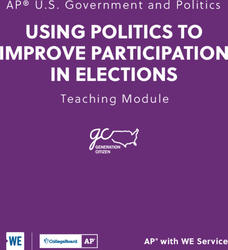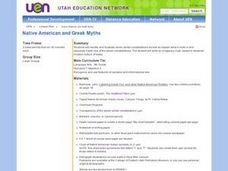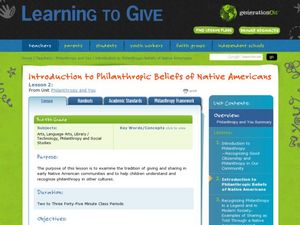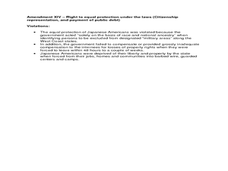City University of New York
Urban Politics: Machines and Reformers
Take a trip to the turn of the twentieth century with a resource about industrialism in America. With primary source documents and focus questions, learners think about the ways that government groups and organizations paved the way...
Library of Congress
Stars, Stripes and Symbols of America: Comparing Our Flag, Past and Present
Your young historians will compare and contrast the details of the American flag today with an an image of the nation's flag from the post-Civil War era, and identify the flag's importance as a national symbol through analysis...
City University of New York
Electoral College
A presidential election is a lot like the 2004 World Series, and it's also a lot like choosing an orange in a paper bag. Apply the process of the electoral college to these two analogies with a set of lessons about government...
Annenberg Foundation
Egalitarian America
What does a true American represent? Scholars investigate the equal rights era of the 1960s and 1970s in the 20th installment of a 22-part series on American history. Using photographic, magazine, written, and video evidence, groups...
New York City Department of Education
Geography and Early Peoples of the Western Hemisphere
Young historians discover the early people of the western hemisphere. The unit explores how the land changed, how it was used and homes of early Americans such as Incas, Mayans, Inuits, Aztecs, and Pueblos. Individuals also examine these...
K12 Reader
An Independent Nation
If your kids are curious about the American Revolution, help them understand more about its background with a reading passage and comprehension questions. Kids use context clues to answer each question, some of which require more...
C-SPAN
14th Amendment Equal Protection Clause
Two Supreme Court cases, Plessy v. Ferguson and Brown v. Board of Education take center stage in a lesson about the Equal Protection Clause of the 14th Amendment. Class members research both cases to compare and contrast the rulings.
College Board
Using Politics to Improve Participation in Elections
Instructors new to teaching AP U.S. Government and Politics classes, as well as seasoned veterans, will find this teaching guide an invaluable resource. Using a project-based approach to civics education, the lessons emphasize real-world...
Judicial Learning Center
The Judge and the Jury: Trial by Jury
Why is it so important to have a trial by jury in the American judicial system? This right is one of the hallmarks of American democracy, but it also comes with the responsibility of serving on a jury if called. Young legal scholars...
State Bar of Texas
White v. Regester
One vote doesn't really matter, right? Class members investigate the concept of voter rights and restrictions using the 1973 Supreme Court case White v. Regester. They view a short video and work in pairs to analyze how people create...
Curated OER
Governance
Students explore government by researching Native American history. In this First Nations culture instructional activity, students define the Aboriginal action of speaking in a circle as a group. Students discuss their likes and dislikes...
Curated OER
Colonial America: Causes Of The American Revolution
Students examine the causes of the American Revolution. In this colonial America lesson plan, students read handouts regarding the sequence of events that led to the commencement of the war. Students complete the provided worksheets and...
Curated OER
The Three Branches of Government
Seventh graders discover details about the responsibilities of the 3 branches of government in the United States. In this checks and balances lesson, 7th graders view a SMART Board supported lecture that reveals the jobs of the...
Curated OER
Governance - Grade 7
Young scholars examine the governance of natives in Canada. In this native studies lesson, students read handouts on the Iroquois and Huron Confederacies and then respond to discussion questions about the 2 governance systems.
Curated OER
Encounters – Native Americans and Euro Americans (1850-1870)
Students consider the plight of Native Americans. In this Oregon history lesson, students research Internet and print sources regarding land conflicts between the whites and Native Americans. Students discuss resettlement and...
Curated OER
AIH-15: Colony Settlement & American Indian Involvement
Students examine American Indian individuals and tribes involved in the settlement of English colonies.
Curated OER
Dorothea Lange and the Relocation of Japaneses Americans
Learners analyze Dorothea Lange's photographs about Japanese American relocation. In this art and history lesson, students analyze a photograph about the relocation of Japanese Americans. Learners discuss the impact of governmental...
Curated OER
Native American and Greek Myths
Fifth graders identify seven different constellations and explain a myth that accompanies it. As a class, they listen to myths associated with the Greek and Native American cultures. To end the lesson, they write their own myth related...
Curated OER
Philanthropic Beliefs of Native Americans
Students examine the tradition of giving and sharing in early Native American communities. In this philanthropy lesson, students define the term philanthropy, list 3 traditions of Native American giving and sharing, and identify 3...
Curated OER
Mexican and American Views of Texas
Learners study the territorial status of Texas in 1830, 1840, and 1846 and interpret an historical timeline. They develop a general statement of Mexican and American views of Texas.
Curated OER
The Bill of Rights And Japanese Internment
Students review the Bill of Rights. They interpret how the American Government violated these rights with regard to Japanese Americans during World War II. They write down the violations of the Bill of Rights during Japanese ...
Curated OER
Dorothea Lange and the Relocation of Japanese Americans
Students consider the relocation of Japanese Americans during World War II. In this Japanese relocation lesson plan, students examine photographs by Dorothea Lange, the "Pledge of Allegiance," and a US government flyer from 1942. They...
Curated OER
Evacuation: The Japanese Americans in World War II
Students examine Japanese internment camps of World War II. In this World War II lesson, students use primary and secondary sources to research the evacuation process and life within the internment camps. Students discuss the racial bias...
Curated OER
Government Mobile
Fourth graders, after studying the three branches of state government and gathering together a variety of art materials, create a mobile explaining all three branches of the government. They display their mobiles inside the classroom for...























